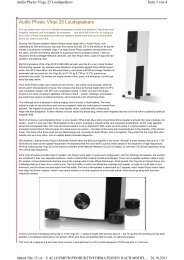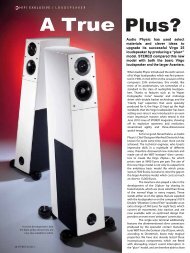Audio Physic Avantera Loudspeaker (TAS 220)
Audio Physic Avantera Loudspeaker (TAS 220)
Audio Physic Avantera Loudspeaker (TAS 220)
You also want an ePaper? Increase the reach of your titles
YUMPU automatically turns print PDFs into web optimized ePapers that Google loves.
inert, resonance-and-diffraction-free platform for the three drivers that handle almost all of the music—<br />
the frequencies from roughly 150Hz up. As was the case with the M Series Magicos, the rest of the<br />
<strong>Avantera</strong>’s enclosure is heavily braced wood—well, MDF in the <strong>Avantera</strong>’s case—with an elaborate<br />
internal architecture of open and sealed chambers, designed (as is every other part of the speaker,<br />
including its optional, highly recommended VCF feet) by AP’s brilliant chief engineer Manfred<br />
Diestertich to lower typical cone colorations and facilitate the smooth blending of the drivers.<br />
Since the days when Joachim Gerhard ruled the roost, <strong>Audio</strong> <strong>Physic</strong> has used “narrow-baffle” cabinets,<br />
and the <strong>Avantera</strong>’s front panel is a mere 9.4" wide. Though narrow baffles (when properly designed)<br />
unquestionably allow loudspeakers to better “disappear” as sound sources—and the <strong>Avantera</strong> does this<br />
as well as any speaker I’ve reviewed—they can also create what is known as a baffle-step issue. For<br />
those of you who don’t know what this phrase means, “baffle-step issue” refers to suckout in the allimportant<br />
power range, between approximately 100Hz and 500Hz. This suckout occurs when the<br />
wavelengths that the midrange driver is reproducing are longer than the (narrow) baffle the midrange<br />
cone is mounted on. In the absence of a wider baffle, these longer wavelengths “wrap around” the<br />
enclosure, and the driver starts to work in a 4pi (omnidirectional) radiation pattern instead of a 2pi<br />
(hemispherical) one. The consequent reduction in acoustic efficiency (there is substantially less sonic<br />
energy directed toward you, the listener, in those frequencies that are being radiated omnidirectionally<br />
than in those that are radiated hemispherically) can in turn produce an acoustic hole—a valley as deep<br />
as 6dB in the lower midband and upper bass, easily heard as a marked thinning down of timbre, power,<br />
and body.<br />
Though certain reviewers seem to feel that this baffle step issue just “comes with the territory” of<br />
narrow-front loudspeakers—and can only be corrected by DSP or tone controls—designers like<br />
Diestertich aren’t as oblivious to the problem as these Doubting Thomases seem to think. By ensuring<br />
that the midrange driver (in the <strong>Avantera</strong>’s case, the separate 5.9" lower-midrange driver) is capable of<br />
operating linearly down to 100Hz, and side-mounting the 7" woofers on a narrow baffle (in the<br />
<strong>Avantera</strong>’s case, four woofs per speaker, two on each side, operating in a push-push configuration that<br />
cancels out cabinet vibration), and setting the crossover between the woofers and the lower midrange<br />
driver at 150Hz, you get the RTA printed at the top of p. 104.<br />
See any baffle-step problem here? I don’t. Nor, more importantly, do I hear one. Indeed, this graph<br />
(taken at 5dB/division and one-sixth-octave smoothed) is high among the most linear in-room<br />
frequency-response charts I’ve taken—not just through the power range but overall.<br />
Though I am anything but a measurement-first kind of listener and take these RTAs (via Dayton<br />
<strong>Audio</strong>’s fabulous OmniMic Precision Measurement System) only after weeks or months of listening,<br />
I’ve found that—regardless of the relative coarseness of such metrics compared to the wonders of the<br />
human ear—they do reflect the tonal balance I hear in my listening room with my ancillary gear. The<br />
plain truth is that the <strong>Avantera</strong> not only measures as if it is a superlative single-driver speaker; it sounds<br />
that way.<br />
Beyond the highly engineered enclosure, a good deal of the credit for this feat has to go to the<br />
Diestertich-designed drivers (made for the company, using AP tools, by a company founded by former<br />
VIFA engineers). While they may not have the sex appeal of Magico’s and Rockport’s carbon-fibersandwich<br />
numbers, AP’s cones are—trust me—very high-tech and exceptionally well blended. Indeed,<br />
the <strong>Avantera</strong>’s tweeter, midrange, and lower midrange have much the same octave-to-octave<br />
seamlessness and “single-driver” sound as the tweeter and mid/woof in the most seamless cone speaker<br />
I’ve heard to date, the Magico Q1 (reviewed in our last issue), bespeaking extremely high linearity and<br />
low distortion.<br />
Let’s take a closer look at those drivers, starting with the <strong>Avantera</strong>’s unusual tweeter. As AP points out






